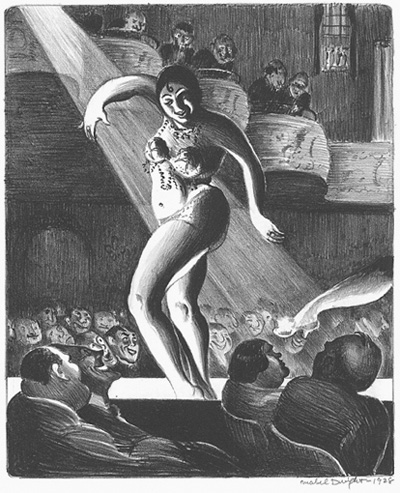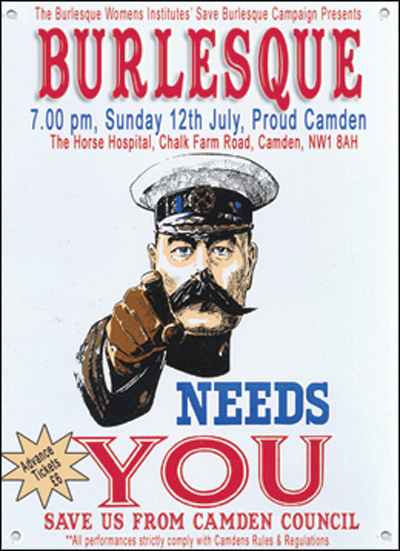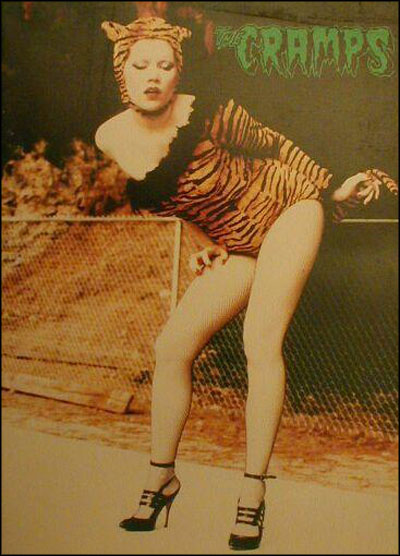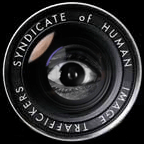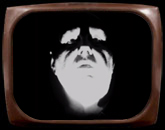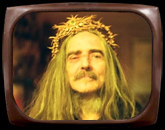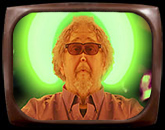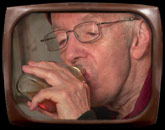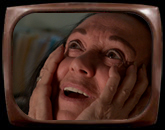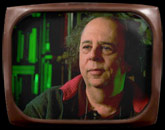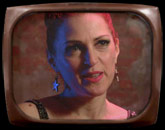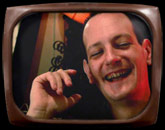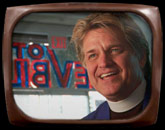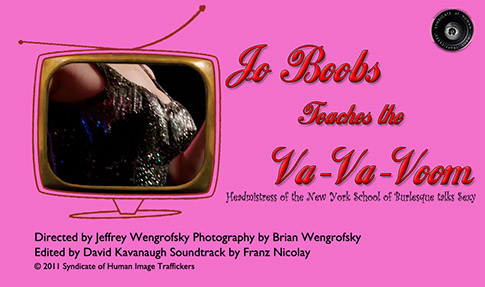

Jo Boobs Teaches the Va-Va-Voom
Jo Boobs Teaches the Va-Va-Voom will be screened as part of a program of the films of Jeffrey Wengrofsky at the Howl! Happening in New York City on April 9, 2016.
Jo Boobs Teaches the Va-Va-Voom made its theatre debut at Microscope Gallery in Bushwick, and was screened at Reelfest Boston 2012 and was shown on May 24, 2013 as part of a Syndicate-only program at The Norwood Club’s Sound & Vision series.
All but her belly buried in the floor;
And the lewd trounce of a final muted beat!
We flee her spasm through a fleshless door…
Then you, the burlesque of our lust — and faith,
Lug us back lifeward — bone by infant bone.
— Hart Crane, “National Winter Garden,” (1930)
“Jo Boobs” Weldon is Headmistress of The New York School of Burlesque, whose home at The Slipper Room is just a few blocks from where Lydia Thompson’s “London Blondes” brought burlesque to America and a stone’s throw from where Minsky’s original National Winter Garden made burlesque part of the American vernacular. Minsky’s notoriously established Gypsy Rose Lee as an icon synonymous with striptease, and launched the careers of Abbott and Costello, Phil Silvers and Robert Alda before being closed in the name of public morality.
Is burlesque – a word which refers to turning things upside down – still able to subvert morals and mores? In a popular culture where the use of sexuality to sell consumer goods is banal, pornography of nearly every stripe is freely and instantly available, and sympathetic gay and lesbian characters are commonplace, is the self-conscious performance of gender merely campy fun or does it still have a liberating capacity? Can sex work, titillation, gender play and masturbation undermine heterosexual monogamy? Whose moralities and identities might they challenge?
Catherine MacKinnon argues that sexualized depictions of women in patriarchal societies reinforce misogyny to the point of constituting a form of violence. Do sexualized performances by women lead to their individual and collective debasement? Is stripping a phenomenon where women who appeal most to men are degraded whereas burlesque liberates women who stand outside the norms of beauty as prescribed by male desire? Considering stripping and prostitution, I ask whether everyone sells their bodies at every job? Further, when men pay a high premium to be with a woman or just to look at one, whose body is exploited? More specifically, does it make sense to import 20th Century standards of judgment to a 21st Century United States whose educational system produces more female post-graduates than male and whose career women earn 94.2% of the income of their male counterparts? Despite shifts in income and status, why do so few straight males study burlesque or work as strippers?
Jo Boobs and I met at the basement headquarters of her school on the coldest evening in recent years to explore questions of gender, activism, and whether she and her ilk are gender traitors or gender busters. She even stripped down to fighting gear for an intimate performance caught by our unblinking digital eyeball. (See above!) In June 2010, Jo will publish The Pocket Book of Burlesque (with a forward by Margaret Cho), a volume whose slender design can slip under the inspector’s prying gaze. The New York School of Burlesque is in sympathetic affiliation with Miss Indigo Blue’s Academy of Burlesque in Seattle and Michelle L’Amour’s Burlesque Finishing School in Chicago as well as programs in Washington, D.C and elsewhere. When will someone open a campus in Tehran?
S.H.I.T.
How does burlesque differ from stripping?
Jo Boobs
To understand the difference, look at it from the audience’s point of view. If someone goes to a strip joint, they usually go in whenever they want, they pick the performer they want, they negotiate how they interact with them, they interact one-on-one, and they leave. When they go to a burlesque show, the show starts at a [predetermined] time, they pay a cover (not the performers), they watch the show, there isn’t usually any one-on-one interaction, and they leave when the performance is over.
S.H.I.T.
I would also imagine that sexual titillation is the priority for someone at a strip club whereas entertainment, costuming, dance or some fantastic tableau may be the driving interest for someone at a burlesque revue.
Jo Boobs
From the performer’s point of view, the difference is mostly of intention. A dancer in a strip joint is at least trying to tailor her performance to maximize her income – a noble pursuit – by putting the erotic qualities up front, whereas burlesque numbers tend to be more glamorous, with a greater focus on costumes than nudity and on creative content. Some people don’t like making a distinction because it seems as though you have to privilege one to the other, but it is necessary to do so when describing to a potential producer or someone who may host your event at their venue, you have to be able to.
S.H.I.T.
The New York School of Burlesque is just three blocks from where Minsky’s Burlesque was once located. Do you feel like burlesque has a natural home in the Lower East Side?
Jo Boobs
Yes, absolutely, I really do. This is where burlesque first came to from England and developed into the combination of satire and girly show we now know it as.
S.H.I.T.
Many of the performers have costumes with traditional flourishes. What is the role of tradition in burlesque?
Jo Boobs
There is a strong nod to the retro, a fascination with the stylings of pin-ups and strippers of the 40s and 50s.
S.H.I.T.
Burlesque’s heyday was the 1920s and 30s – with Gypsy Rose Lee and others. Why is it that people would focus on the 1950s?
Jo Boobs
The heyday of burlesque is hard to pin down. In Burleycue: An Underground History of Burlesque Days, Bernard Sobel, writing in the 30s, argues that burlesque died then. [Others] argue that it died when [Fiorello LaGauradia] passed a law making it illegal to use the word “burlesque” on a marquee and some argue that it died in the 50s or in the 60s with nude beaches. It’s just like rocknroll – it’s been killed a hundred times. There isn’t one heyday for burlesque, although striptease is easier to associate with one era. Once striptease had put a generation behind it, [burlesque] had a stigma. When I see women who did burlesque in the 40s or 50s, I see women who were fierce in the face of this stigma. I’ve talked to some of them – the actual women from photographs. Their lives were not easy. The women who did burlesque in the 20s and 30s had even more stigma. Some say that I’m celebrating an era when women were oppressed [whereas] I’m celebrating the spirit of women who were denigrated but insisted on being fierce and glamorous, anyway. They did not always choose this life. Other performers on their bills – comedians, actors, dancers, singers – could move into other media. The art of striptease artists was not allowed to travel in this way – they were outcasts.
S.H.I.T.
It has been argued that burlesque helped to break down the gender roles of the Victorian age by women removing their highly-encoded, restrictive head-to-toe coverings in public.
Jo Boobs
In the second half of the 18th Century, burlesque artists sometimes dressed like men or somewhere in between, as argued by Robert Clyde Allen in Horrible Prettiness. Lucky, who teaches burlesque at [New York University], suggests that what had shocked people was that gender was blurred. [Women] were dressed in tights – as only men had been allowed – and sang and made jokes and addressed the audience directly, in a male way. It was not just the nudity, but the inappropriateness. I’ve always celebrated inappropriateness in burlesque.
S.H.I.T.
Among other things, burlesque means turning things upside down, a spirit of transgression. When Lydia and her troupe of blondes came to the U.S. at the origin of burlesque, dressing in a male and highly sexualized way, was partly responsible for the success and notoriety of the art form.
Jo Boobs
Definitely. I’ve been hanging out with drag queens and heavy metal dudes all my life. I’ve always wanted to play with gender like they do by playing up female characteristics sometimes to the point where people think I’m a guy in drag. That’s entertaining for me.
S.H.I.T.
Like Victor Victoria! When and where did the most recent burlesque revival begin?
Jo Boobs
The current wave began in Los Angeles and New York in the mid-90s. In Los Angeles, “The Velvet Hammer” was a self-conscious effort to create a modern burlesque show with a Cramps-style nod to the past. They were friends with The Cramps, so it was no coincidence. In New York, we were doing things in different venues: I was doing it in strip joints, Tigger was doing it with Penny Arcade in “Bitch! Dyke! Faghag! Whore!” at gay bars, Dirty Martini was doing it at “Pink Inc.,” Julie Atlas Muz was doing it at Serena Vixen’s “Red Vixen Show,” and Bonnie Dunn was doing it at “Blue Angel.” Kate Valentine of The Velvet Hammer also had a show in New York were all of these performers would do their numbers. At the time, there was no burlesque scene, but we were all interested in these images, flappers, iconic women of other ages, trying to put ourselves in their shoes, getting naked, and being generally irreverent while we do it. It’s still transgressive even if nudity doesn’t have the same meaning as it did in the Victorian era. It’s not something you do in an office and you don’t do it seductively in front of the children. In a class society, your primary status – what you do for a living – is described by the way you dress. Stripping has the connotation of: “Deal with my body. What do you see when you just see my decorated body, not my dressed body?” I’m not the biggest nudist, but I live with Julie Atlas Muz. She’s a nudist! It’s like living with clowns – it’s the best thing ever! I’m still uptight about nudity because I worked in the nude for a living. It has a certain specific place in my life. It’s still transgressive.
S.H.I.T.
It certainly puts you in jeopardy in a variety of ways. There are some detractors who will say that you are feeding into women sexually objectifying themselves. How do you respond to this?
Jo Boobs
In some cases, it’s just true, but it’s not degrading every time someone is seen as a sexual object. I don’t have a lot of experience with 1980s-style feminist interpretations of what gender means: the horrors of the male gaze. [It’s the idea that] every time a man enjoys looking at a woman, he objectifies her and degrades her. I understand that if someone works at places like trauma centers or in trafficking, they may come to see men that way, but I don’t. Even in the sex industry, all men are not like that. I’ve met men like that, but only some men are like that and only under some circumstances. In the same way, some women performers seek that attention and some do not. It should be seen on a case-by-case basis. Until you judge each specific situation, you can’t address what’s going on or the underlying causes. Some people are just too skewed to see what’s going on. What I see in burlesque are women who say, “Fuck it! If I do not conform to Victoria’s Secret models or wear the make up or hair style or shoes that I’m supposed to wear, or if I’m fatter or skinnier or deformed, if you don’t like it, it’s your problem, not mine. I don’t need permission from Howard Stern’s interns to be hot enough to have fun.” I don’t see how that’s not feminist. I know that there are certain privileges given to people with a certain appearance, but I’m still going to have this. I’ve never met a guy who says, “I can’t wait to meet a girl who wears false eye lashes on the top and bottom of her eyes, wears a lot of feathers, and glues things to her nipples.” The idea that we are adhering to the dictates of the male gaze is beyond my comprehension.
S.H.I.T.
Whereas in a strip show, the performance has its climax at the legal limit of nudity or contact, whereas, in burlesque, the journey – the performance – is the climax. Further, there are easily as many women in a burlesque audience as men and many of them men may be gay or bisexual. It doesn’t seem like a particularly heterosexist occasion.
Jo Boobs
I’m not saying that burlesque is all of these things to all people all of the time, but our performers are generally gender curious and choosing what they do. They don’t get paid more to act more feminine, whereas in a strip joint they [would]. Our performers define what they do, not the other way around. Our audience wants to be shocked and awed. That said, strip joints are not the natural opposite of burlesque. They are not places where men go just to be awful to women. I didn’t experience the sex industry that way and I was in it for fifteen years. The idea that to be sexualized is always degrading does not make sense to me. I have experienced being sexualized as degrading and as liberating. Any polarization is going to be inaccurate. I have this perspective, not because I am privileged, but because I have actually worked with, literally, thousands of other women in these situations. As an activist, I have spoken with women from all over the world who didn’t wish to be infantilized or described as helpless, who didn’t want their choices to be automatically categorized as invalid or to be called “Uncle Toms” for their decisions. There is a wide range of experience out there. Those who see objectification and exploitation operating one hundred percent of the time are not looking at what’s going on most of the time. It isn’t the only form of male behavior. Catherine MacKinnon says that it is the definition of “male,” but she doesn’t see her privilege as a skinny, white woman sitting in an ivory tower.
S.H.I.T.
Catherine MacKinnon is the very definition of privileged. Clan MacKinnon is an immensely wealthy family with its own island.
Jo Boobs
Linda Lovelace said, in my presence, that she felt just as exploited to the same degree by MacKinnon and Andrea Dworkin as by her ex-husband.
S.H.I.T.
When did you start the New York School of Burlesque and why?
Jo Boobs
It started about five years ago with a class people asked me to teach.
S.H.I.T.
What classes are taught?
Jo Boobs
We teach basic movement classes, so people can a bump from a grind and what a peal and a tassel twirl are. We also teach isolations – which are healthy and useful for communicating. Dr. Lucky teaches theater classes and the World Famous BOb teaches glamour and confidence classes.
S.H.I.T.
You teach women how to own the room – not be owned by the room.
Jo Boobs
That’s a good way of describing it. Bob and Lucky have unique approaches that you can’t get anywhere else. I have been training Darlinda Just Darlinda and Gal Friday to teach my classes, and they’ve started their own. Peekaboo Pointe teaches from a pilates background and Angie Pontani teaches go-go. I’m about to teach a class where, at some point, in each act, women will appear male. I play Satan.
The Syndicate of Human Image Traffickers Thanks You For Your Time and Interest
